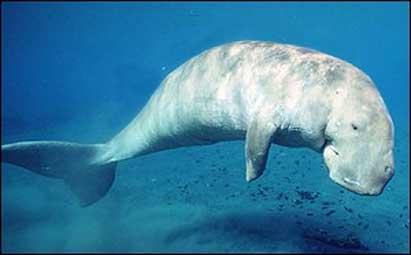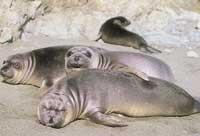Manatees, environmental status indicators under threat
2002/02/24 Mendiburu, Joana - Elhuyar Zientziaren Komunikazioa
The United Nations Environment Programme has analyzed the evolution of manatee populations and drawn considerable conclusions. This mammal, an environmental indicator, is threatened and reduces its distribution area.
Animals that inspired the myth of mermaids

Manatee is a thick herbivore and aquatic mammal. Species of the Dugong family that is classified in the order of the mermaids. It can reach three meters long and 400 kilos of weight and lives on the coast, in temperate waters of 20-35ºC. As for their character, many go alone or as a couple and others in small groups. Their biology is not well known, but studies show that every 5-10 minutes they rise to the surface to breathe.
But manatees are known because more than these general characteristics inspired the myth of the mermaids (at least that is said). According to scientists, ancient travelers considered manatees as semi-heavy and semi-fishes. It is said that these great mammals were those who, with their melodic voice, attracted the men of the sea to the trap, and that is why it is called the order of these mammals of the Sirens.
However, although animals are very friendly, if we take time to analyze them from the current point of view, this hypothesis is questionable, since it seems surprising to mix these fish with slender young girls. But well, loneliness and alcohol open the imagination and who knows in what situation the sirens got right.
However, they are currently environmental indicators and therefore have become serious research topics. The latest study was conducted within the United Nations Environment Programme, under the direction of Helene Marh, professor at the Australian University James Cook.

The situation is serious and research shows that the time has come to light the red light. In addition, as an indicator species of the environment, the worsening of its situation shows a worsening of the state of the other species and habitats.
The investigation was presented at the meeting of the Colombian city of Kartagena, where the environment ministers met. In the words of Helene Marh, "Manatees have disappeared from some places because they have fled or died."
Mauritania, Seychelles, western Sri Lanka, Maldives, some places in Japan, the Pearl River estuary in Hong Kong, some Philippine islands, Cambodia and Vietnam are some of these places.
Elsewhere, although the manatee population has not disappeared, it has declined. Exceptions may be Australian waters, the Red Sea and the Arab Gulf.
Helene Marsh has made a special mention of the serious situation in East Africa and warns that if something is not done shortly they will also disappear from it.
Once again man's guilt

This serious state of the manatee population is due to human pressure. In particular, pollution from land to sea, coastal development and marine animal trafficking are responsible. In fact, the main food of this mammal are aquatic plants, which being the sea increasingly polluted and asphalted, are reducing food sources.
The remains of herbicides worldwide reach the sea and destroy herbs and seaweeds. Therefore, the animal, forced, moves away from the regions where more food is found and dies if no appropriate place is found.
On the other hand, these animals have long been hunted for their skin and their fat and, at present, only a few thousand remain, about half of them on the Australian coast. The birth rate is relatively low and although protective measures are established, year after year, the number of animals increases only 5%. Although manatee hunting is prohibited, it is still hunted in many countries and, in addition, when there is little food, females measure births and do not make a second child.

To change this situation, the authors of the new research believe that it is necessary to deepen collaboration between countries. In fact, belied by existing convictions, research has shown that these mammals are able to travel about 600 km in a few days.
On the other hand, aware of this situation, or the Environment Ministers meeting in Kartagena, should move concrete proposals to the UN summit on sustainable development to be held in Johannesburg between 26 August and 4 September this year, on the safety in the use of hazardous chemicals, among other issues.
Published in the supplement Estación de Gara.

Gai honi buruzko eduki gehiago
Elhuyarrek garatutako teknologia






